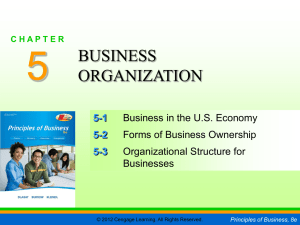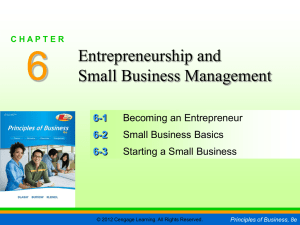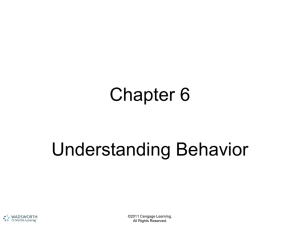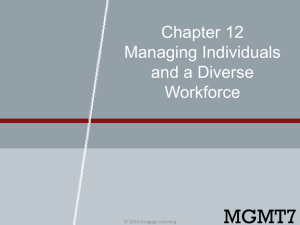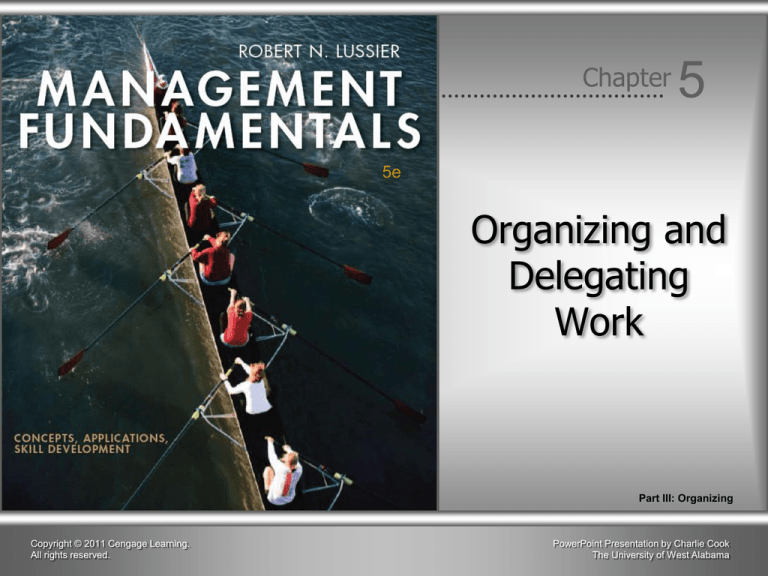
Chapter
5
5e
Organizing and
Delegating
Work
Part III: Organizing
Copyright © 2011 Cengage Learning.
All rights reserved.
PowerPoint Presentation by Charlie Cook
The University of West Alabama
Learning Outcomes
After studying this chapter, you should be able to:
1. Explain the difference between a flat organization and
a tall organization.
2. Describe the similarities and differences among liaisons,
integrators, and people in boundary roles.
3. Discuss the difference between formal and informal authority
and centralized and decentralized authority
4. List and briefly explain the four levels of authority.
5. Describe the relationship between line authority and staff
authority.
6. Explain what an organization chart is and list the four aspects
of a firm that it shows.
Copyright © 2011 Cengage Learning. All rights reserved.
5–2
Learning Outcomes (cont’d)
After studying this chapter, you should be able to:
7. Discuss the difference between internal and external
departmentalization.
8. State the similarities and differences between matrix and
divisional departmentalization.
9. Explain the difference between job simplification and job
expansion.
10. Describe the job characteristics model.
11. Explain how to set priorities by answering three priority
questions and determining whether activities have high,
medium, or low priority.
12. List the four steps in the delegation process.
13. Define the key terms listed at the end of the chapter.
Copyright © 2011 Cengage Learning. All rights reserved.
5–3
IDEAS ON MANAGEMENT at Volkswagen
1. What are the important organizational principles
guiding Volkswagen in achieving its goal of
becoming the world’s largest automaker?
2. Would you say that Volkswagen is centralized or
decentralized? Why?
3. How has micromanaging affected the operations of
Volkswagen?
4. What prioritization issues does Volkswagen face?
Copyright © 2011 Cengage Learning. All rights reserved.
5–4
Exhibit 5–1 ● Organizing Questions
Copyright © 2011 Cengage Learning. All rights reserved.
5–5
Exhibit 5–2 ● Principles of Organization
• Unity of command and direction
• Chain of command
• Span of management (flat and tall organizations)
• Division of labor (specialization, departmentalization,
integration)
• Coordination
• Balanced responsibility and authority
• Delegation
• Flexibility
Copyright © 2011 Cengage Learning. All rights reserved.
5–6
Coordination Methods
Direct Contact
Boundary Roles
Integrators
Copyright © 2011 Cengage Learning. All rights reserved.
Liaisons
Committees
5–7
Balanced Responsibility and Authority
• Responsibility
The obligation to achieve objectives by performing
required activities.
• Authority
The right to make decisions, issue orders, and use
resources.
• Accountability
The evaluation of how well individuals meet their
responsibilities.
Copyright © 2011 Cengage Learning. All rights reserved.
5–8
Balanced Responsibility and Authority
(cont’d)
• Delegation
The process of assigning responsibility and authority
for accomplishing objectives.
• Flexibility
The ability to adapt to exceptions to the rules,
policies, and procedures of the organization.
Copyright © 2011 Cengage Learning. All rights reserved.
5–9
Copyright © 2011 Cengage Learning. All rights reserved.
5–10
Join the Discussion
Ethics & Social Responsibility
• Breaking the Rules
1. Is it unethical to be flexible and break the law
against kickbacks?
2. Why are kickbacks illegal? Who benefits from
kickbacks, who gets hurt by them, and how?
3. What would you do in this situation? (Would you
start giving kickbacks yourself? Blow the whistle
on sales reps to their managers? Blow the whistle
to an outside source like the government or the
media? Do nothing?)
Copyright © 2011 Cengage Learning. All rights reserved.
5–11
Authority
• Formal Authority (or Structure)
The organizationally-sanctioned way of getting the
job done.
Organizational charts illustrate formal lines of authority in
firms.
• Informal Authority
The patterns of relationships and communication that
evolve as employees interact and communicate that
is not sanctioned by the organization.
• Scope of Authority
A hierarchy that narrows as it flows down the
organization.
Copyright © 2011 Cengage Learning. All rights reserved.
5–12
Exhibit 5–3 ● Scope of Authority
Responsibility and
Scope of Authority
Copyright © 2011 Cengage Learning. All rights reserved.
5–13
Levels of Authority
1. Authority to Inform
Inform a superior of action alternatives and the
superior makes the decision.
2. Authority to Recommend
List alternatives/actions and recommend one
action; superior makes action decision.
3. Authority to Report
Select and implement a course of action, reporting
action to superior.
4. Full Authority
Acting independently without supervision.
Copyright © 2011 Cengage Learning. All rights reserved.
5–14
Line and Staff Authority
• Line Authority
The responsibility to make decisions and issue orders
down the chain of command.
• Staff Authority
The responsibility of staff personnel to advise and
assist line and other personnel.
Functional authority
The right of staff personnel to issue orders to line personnel
in established areas of responsibility.
Dual line and staff authority
Staff personnel exercise line authority within their own
departments.
Copyright © 2011 Cengage Learning. All rights reserved.
5–15
Line and Staff Authority (cont’d)
• General Staff
Work for only one manager and help the manager in
any way needed.
• Specialist Staff
Help anyone in the organization who needs it.
Copyright © 2011 Cengage Learning. All rights reserved.
5–16
Micromanagement
• Micromanagement
Is a management style where a manager’s close control the
work of subordinates delays decisions, clouds goals and
objectives, restricts information, discourages participation and
trust, decreases motivation and stifles innovation.
• Avoiding Micromanagement
Clearly articulate expectations.
Focus on hiring and placement of subordinates.
Give employees decision-making power.
Encourage questions and suggestions.
Offer constructive feedback.
Don’t grab the reins at the first sign of trouble.
Copyright © 2011 Cengage Learning. All rights reserved.
5–17
Centralized and Decentralized Authority
• Centralized Authority
Important decisions are
made by top managers.
• Decentralized Authority
Important decisions are
made by middle and firstline managers.
Copyright © 2011 Cengage Learning. All rights reserved.
5–18
Exhibit 5–4 ● Types and Levels of Authority
Copyright © 2011 Cengage Learning. All rights reserved.
5–19
Copyright © 2011 Cengage Learning. All rights reserved.
5–20
Organizational Design
• Contingency Factors Affecting Structure
Environment (mechanistic versus organic)
Production technology
Strategy (“structure follows strategy”)
Size of the organization (larger = more formal)
• Organization Chart
A graphic illustration of the organization’s
management hierarchy and departments and
their working relationships.
Level of management hierarchy, chain of command, the
division and type of work, and departmentalization.
Copyright © 2011 Cengage Learning. All rights reserved.
5–21
Exhibit 5–5 ● Organization Chart
Copyright © 2011 Cengage Learning. All rights reserved.
5–22
Departmentalization
• Departmentalization
Is the grouping of related activities into units.
• Types of Departmentalization
Functional departmentalization
Based on the internal operations or functions that the
employees perform and the resources needed to accomplish
that work.
External, or output, departmentalization
Based on activities or factors outside the organization:
product, customer, or territory.
Multiple Departmentalization
Hybrid structure: matrix and divisional (SBUs)
Copyright © 2011 Cengage Learning. All rights reserved.
5–23
Exhibit 5–6 ● Types of Departmentalization
Copyright © 2011 Cengage Learning. All rights reserved.
5–24
Multiple Departmentalization
• Hybrid structures using combinations of
functional and product departmentalization
• Matrix Departmentalization
Unity of command
Coordination issues
• Divisional Departmentalization
Is based on semiautonomous business units.
Uses a conglomerate structure of unrelated business
units: autonomous profit centers.
Copyright © 2011 Cengage Learning. All rights reserved.
5–25
Exhibit 5–7 ● Matrix Departmentalization
Copyright © 2011 Cengage Learning. All rights reserved.
5–26
Copyright © 2011 Cengage Learning. All rights reserved.
5–27
Applying the Concept 3 ● (cont’d)
Copyright © 2011 Cengage Learning. All rights reserved.
5–28
New Approaches to Departmentalization
Horizontal Team
Organizations
Learning
Organizations
Departmentalization
Network
Structures
Virtual
Organizations
Copyright © 2011 Cengage Learning. All rights reserved.
5–29
Job Design
• Job Design
Is the process of identifying tasks that each
employee is responsible for completing.
Affects job satisfaction and productivity.
Copyright © 2011 Cengage Learning. All rights reserved.
5–30
Exhibit 5–8 ● Job Design Options
Job Simplification Eliminate tasks
Combine tasks
Change task sequence
Job Expansion
Rotate jobs (job rotation)
Add tasks (job enlargement)
Increase task variety and
employee responsibility (job
enrichment)
Work Teams
Integrated
Self-managed
Copyright © 2011 Cengage Learning. All rights reserved.
5–31
Exhibit 5–9 ● The Job Characteristics Model
Copyright © 2011 Cengage Learning. All rights reserved.
5–32
Copyright © 2011 Cengage Learning. All rights reserved.
5–33
Setting Priorities
• Priority-Determination Questions
1. Do I need to be personally involved because of my unique knowledge
or skills?
2. Is the task my responsibility, or will it affect the performance or
finances of my department?
3. When is the deadline—is quick action needed?
• Assigning Priorities
Delegate (D) priority: Delegate task if the answer to question 1 is no.
High (H) priority: Assign task a high priority if you answer yes to all
three questions.
Medium (M) priority: Assign task a medium priority if you answer yes
to question 1 but no to one of the remaining two questions.
Low (L) priority: Assign task a low priority if you answer yes to
question 1 but no to both questions 2 and 3.
Copyright © 2011 Cengage Learning. All rights reserved.
5–34
Exhibit 5–10 ● Prioritized To-Do List
1. Write the task that you must perform on the task line.
2. Answer the three priority questions by placing a Y (yes)
or N (no) in the relevant column.
3. Assign a priority to the task by placing the letter D (delegate), H
(high), M (medium), or L (low) in the priority column.
4. Determine which task to complete now.
Copyright © 2011 Cengage Learning. All rights reserved.
5–35
Delegation
• Benefits
More time for other
high-priority tasks.
Trains employees
and improves their
self-esteem.
Enriches jobs and
improves personal
and work outcomes.
Copyright © 2011 Cengage Learning. All rights reserved.
• Obstacles
Reluctance to stop
doing tasks
personally.
Fear of employee’s
failure to accomplish
task.
Threatened by
employee’s success.
5–36
Exhibit 5–11 ● What to Delegate and What Not to Delegate
Copyright © 2011 Cengage Learning. All rights reserved.
5–37
Join the Discussion
Ethics & Social Responsibility
• Delegating Destroying Documents
1. Is it ethical and socially responsible to delegate the task of
destroying documents that may potentially be used as
evidence of wrongdoing?
2. What would you do if your boss asked you to destroy
documents and you thought the goal was to cover up evidence
of wrongdoing by the firm? (Would you just do it? Say nothing
but neglect to do it? Question your boss’s motives? Look
closely at what you were asked to destroy? Check with your
boss’s boss to make sure it's okay to do it? Tell the boss you
will not do it? Tell the boss to do it himself or herself? Blow the
whistle to an outside source?)
3. If you were charged with destroying evidence, do you believe it
would be a good defense to say, “I was only following orders”?
Copyright © 2011 Cengage Learning. All rights reserved.
5–38
Model 5-1 ● The Delegation Process
1. Explain the need for delegating and the
reasons for selecting the employee.
2. Set objectives that define responsibility,
the level of authority, and the deadline.
3. Develop a plan.
4. Establish control checkpoints and hold
employees accountable.
Copyright © 2011 Cengage Learning. All rights reserved.
5–39
KEY TERMS
•
•
•
•
•
•
•
•
•
authority
centralized authority
decentralized authority
delegation
departmentalization
divisional structure
job characteristics model
job design
job enrichment
Copyright © 2011 Cengage Learning. All rights reserved.
•
•
•
•
•
levels of authority
line authority
micromanagement
organization chart
priority-determination
questions
• responsibility
• span of management
• staff authority
5–40



